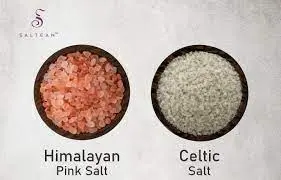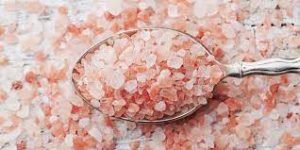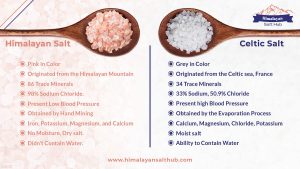Salt is a staple ingredient in every kitchen, but not all salts are created equal. Himalayan salt and Celtic salt are two popular and widely available options, each with its own unique properties and health benefits.
While both salts are derived from natural sources and contain essential minerals, they differ in their taste, texture, and mineral composition.
Origins and Composition
Himalayan Salt:
Harvested from the ancient salt deposits in the Himalayan region, Himalayan salt is renowned for its pink hue, which is attributed to its high mineral content, including trace elements such as magnesium, potassium, and calcium.
Celtic Salt:
Originating from the coastal regions of France, Celtic salt is harvested through the evaporation of seawater. It is typically grayish in color and is known for its rich array of minerals, particularly magnesium and calcium.
Flavor Profile
Himalayan Salt:
Known for its subtle, milder flavor compared to traditional table salt, Himalayan salt imparts a delicate taste to dishes without overpowering other ingredients. Its unique mineral composition adds depth and complexity to culinary creations.
Celtic Salt:
With a slightly briny and mineral-rich flavor, Celtic salt offers a more pronounced taste profile. Its coarse texture and robust flavor make it a favorite among chefs for seasoning meats, vegetables, and soups.
Culinary Uses
Himalayan Salt Benefits:
Apart from its culinary applications, Himalayan salt is also utilized for its therapeutic properties, such as in salt lamps and bath salts. Its gentle flavor makes it suitable for a wide range of dishes, including salads, grilled meats, and desserts.
Health Benefits of Celtic Salt:
Celtic salt is prized for its mineral-rich composition, which may offer various health benefits, including improved electrolyte balance, hydration, and muscle function. It is often used as a finishing salt or in brines for curing meats and seafood.
Nutritional Value
Pink Himalayan Salt Nutrition:
Despite its mineral content, Himalayan salt should be consumed in moderation, as it still primarily consists of sodium chloride. However, its trace minerals can contribute to overall nutrient intake, albeit in small amounts.
Celtic Salt Minerals:
Celtic salt contains a diverse array of minerals, including magnesium, calcium, and potassium, which are essential for various bodily functions. Its unrefined nature ensures that these minerals remain intact, offering potential health benefits.
Health Considerations
Celtic Salt vs Himalayan Salt:
While both salts contain minerals beneficial to health, the choice between Celtic salt and Himalayan salt ultimately depends on individual preferences and dietary needs. Those seeking a milder flavor and subtle mineral notes may prefer Himalayan salt, while others may opt for the bolder taste of Celtic salt.
Celtic Sea Salt Benefits:
Celtic sea salt is often lauded for its purity and mineral richness, as it is harvested from pristine coastal waters. Its lower sodium content compared to table salt makes it a popular choice for individuals looking to reduce their sodium intake without sacrificing flavor.
Differences between Himalayan salt and Celtic salt
While both Himalayan salt and Celtic salt are popular choices for their unique taste and health benefits, there are some key differences between the two that may influence your choice.
Origin and Mineral Content:
Himalayan salt is harvested in the Himalayan mountain range, primarily in Pakistan. It is known for its striking pink color due to its high iron and mineral content. Celtic salt, on the other hand, is harvested off the coast of Brittany in France and retains its natural gray color due to its high mineral content.
Texture and Taste:
Celtic salt has a slightly coarse texture that adds a pleasant crunch to dishes. Its flavor is often described as milder and slightly earthy. On the other hand, Himalayan salt is known for its fine texture and delicate flavor, which is slightly sweeter compared to Celtic salt.
Health Benefits:
Both salts offer similar health benefits due to their mineral-rich composition. However, the mineral content may differ slightly. Himalayan salt is known for its higher iron content, which makes it beneficial for individuals with iron deficiencies. Celtic salt, on the other hand, contains important enzymes that aid in digestion and supports electrolyte balance.
Comparison Table
Aspect |
Himalayan Salt |
Celtic Salt |
|---|---|---|
Origin |
Ancient salt deposits in the Himalayan region | Coastal regions of France |
Color |
Pink | Grayish |
Flavor Profile |
Subtle, milder | Pronounced, mineral-rich |
Composition |
Primarily sodium chloride with trace minerals | Primarily sodium chloride with minerals such as magnesium, calcium, and potassium |
Culinary Uses |
Suitable for a wide range of dishes | Ideal for seasoning meats, vegetables, and soups |
Health Benefits |
Contains trace minerals beneficial to health | Rich in minerals, potentially offering benefits such as improved electrolyte balance and hydration |
Nutritional Value |
Trace minerals contribute minimally to overall nutrient intake | Minerals may contribute to overall nutrient intake in small amounts |
Texture |
Fine-grained | Coarse |
Availability |
Widely available in various forms | Available in specialty stores and online |
Conclusion
When it comes to selecting the right salt for needs your personal preferences, taste, and specific health requirements. While both Himalayan salt and Celtic salt offer unique characteristics and health benefits.
One common misconception is that Himalayan salt is superior simply because of its striking pink color. While the color may be visually appealing, it is the mineral content that truly sets Himalayan salt apart.
Celtic salt is often praised for its natural gray color and milder, slightly earthy flavor. If you are looking for a salt that enhances the taste of your dishes and supports your overall digestion, Celtic salt may be the right choice for you.











Hello!! My name is Annabella
I love to eat, travel, and eat some more! I am married to the man of my dreams and have a beautiful little girl whose smiles can brighten anyone’s day!